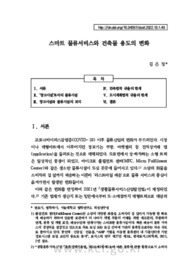

-
미리보기
서지정보
· 발행기관 : 충북대학교 법학연구소
· 수록지 정보 : 과학기술과 법 / 13권 / 1호 / 43 ~ 68페이지
· 저자명 : 김은정
초록
While logistics facilities are getting “smarter” through innovative utilization of technology within them, the legal system still classifies them as “warehouse facilities”. As this gap between the services actually performed in the building and the classification of the building widens, it challenges the proper function of urban planning. This is because the starting point of the main function of urban planning, which arranges buildings and assigns appropriate types and sizes of infrastructure, is to recognize how buildings are actually being used. Due to regulations inconsistent with reality, circumventive logistics facilities are emerging, which will aggravate the failure of urban planning.
Furthermore, being unaware of the actual use of a building means that it is difficult to prevent risks that may occur in the building. The frequent occurrence of fires in more technologically advanced distribution centers in recent years proves this. A critical aspect of the “smart” distribution center is that unlike a traditional “warehouse facility”, there are larger amounts of workers in the center who needs to be protected. Another issue is that often one “smart” distribution center could have multiple state-of-the-art facilities nested under one roof which causes an increased fire risk. In this way, various disasters occurring in the distribution center cannot be prevented.
If delivery services using autonomous vehicles, drones, and robots become common, the way logistics services use urban space will change even more.
Automated facilities will sort and pack, and 24-hour delivery mechanisms will arrive and depart. As technology expedites delivery time and diversifies items that can be delivered, the functions performed by “smart” distribution centers will become more complex. It is time to re-examine the building use regulation, which is the fundamental starting point for proper urban management and the development of the logistics industry.영어초록
While logistics facilities are getting “smarter” through innovative utilization of technology within them, the legal system still classifies them as “warehouse facilities”. As this gap between the services actually performed in the building and the classification of the building widens, it challenges the proper function of urban planning. This is because the starting point of the main function of urban planning, which arranges buildings and assigns appropriate types and sizes of infrastructure, is to recognize how buildings are actually being used. Due to regulations inconsistent with reality, circumventive logistics facilities are emerging, which will aggravate the failure of urban planning.
Furthermore, being unaware of the actual use of a building means that it is difficult to prevent risks that may occur in the building. The frequent occurrence of fires in more technologically advanced distribution centers in recent years proves this. A critical aspect of the “smart” distribution center is that unlike a traditional “warehouse facility”, there are larger amounts of workers in the center who needs to be protected. Another issue is that often one “smart” distribution center could have multiple state-of-the-art facilities nested under one roof which causes an increased fire risk. In this way, various disasters occurring in the distribution center cannot be prevented.
If delivery services using autonomous vehicles, drones, and robots become common, the way logistics services use urban space will change even more.
Automated facilities will sort and pack, and 24-hour delivery mechanisms will arrive and depart. As technology expedites delivery time and diversifies items that can be delivered, the functions performed by “smart” distribution centers will become more complex. It is time to re-examine the building use regulation, which is the fundamental starting point for proper urban management and the development of the logistics industry.참고자료
· 없음태그
-
자주묻는질문의 답변을 확인해 주세요

꼭 알아주세요
-
자료의 정보 및 내용의 진실성에 대하여 해피캠퍼스는 보증하지 않으며, 해당 정보 및 게시물 저작권과 기타 법적 책임은 자료 등록자에게 있습니다.
자료 및 게시물 내용의 불법적 이용, 무단 전재∙배포는 금지되어 있습니다.
저작권침해, 명예훼손 등 분쟁 요소 발견 시 고객센터의 저작권침해 신고센터를 이용해 주시기 바랍니다. -
해피캠퍼스는 구매자와 판매자 모두가 만족하는 서비스가 되도록 노력하고 있으며, 아래의 4가지 자료환불 조건을 꼭 확인해주시기 바랍니다.
파일오류 중복자료 저작권 없음 설명과 실제 내용 불일치 파일의 다운로드가 제대로 되지 않거나 파일형식에 맞는 프로그램으로 정상 작동하지 않는 경우 다른 자료와 70% 이상 내용이 일치하는 경우 (중복임을 확인할 수 있는 근거 필요함) 인터넷의 다른 사이트, 연구기관, 학교, 서적 등의 자료를 도용한 경우 자료의 설명과 실제 자료의 내용이 일치하지 않는 경우
“과학기술과 법”의 다른 논문도 확인해 보세요!
-
일본의 「거래 디지털 플랫폼을 이용하는 소비자의 이익 보호에 관한 법률」에 관한 고찰 - 우리 입법에의 시사점 - 52 페이지
Digital platforms - where businesses supply goods or services, and consumers purchase them - have become essential to our daily lives and to the world economy. Problems such as the distribution of uns.. -
성분화질환자의 성별 자기결정권 확보방안 26 페이지
The gender of the son, according to the purpose of United Nations Convention on the Rights of the Child, Article 12, should be determined after considering his opinion in accordance with age and matur..
문서 초안을 생성해주는 EasyAI

